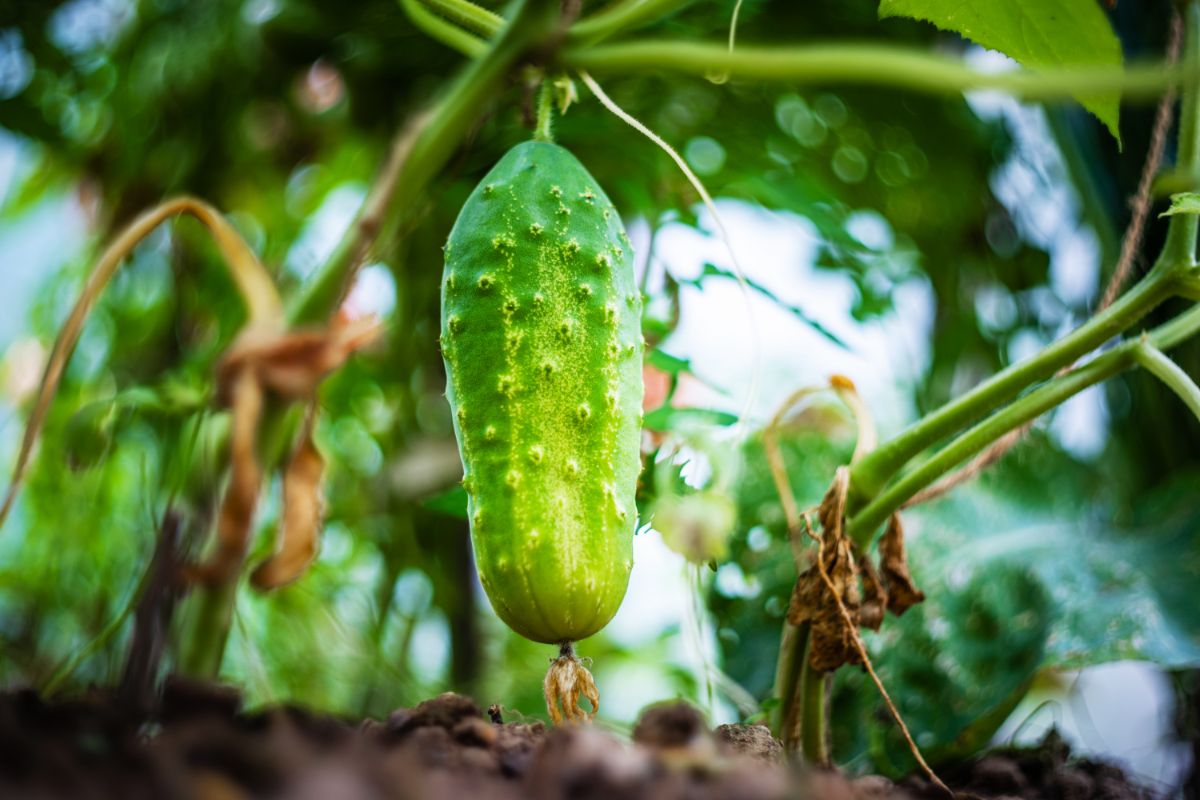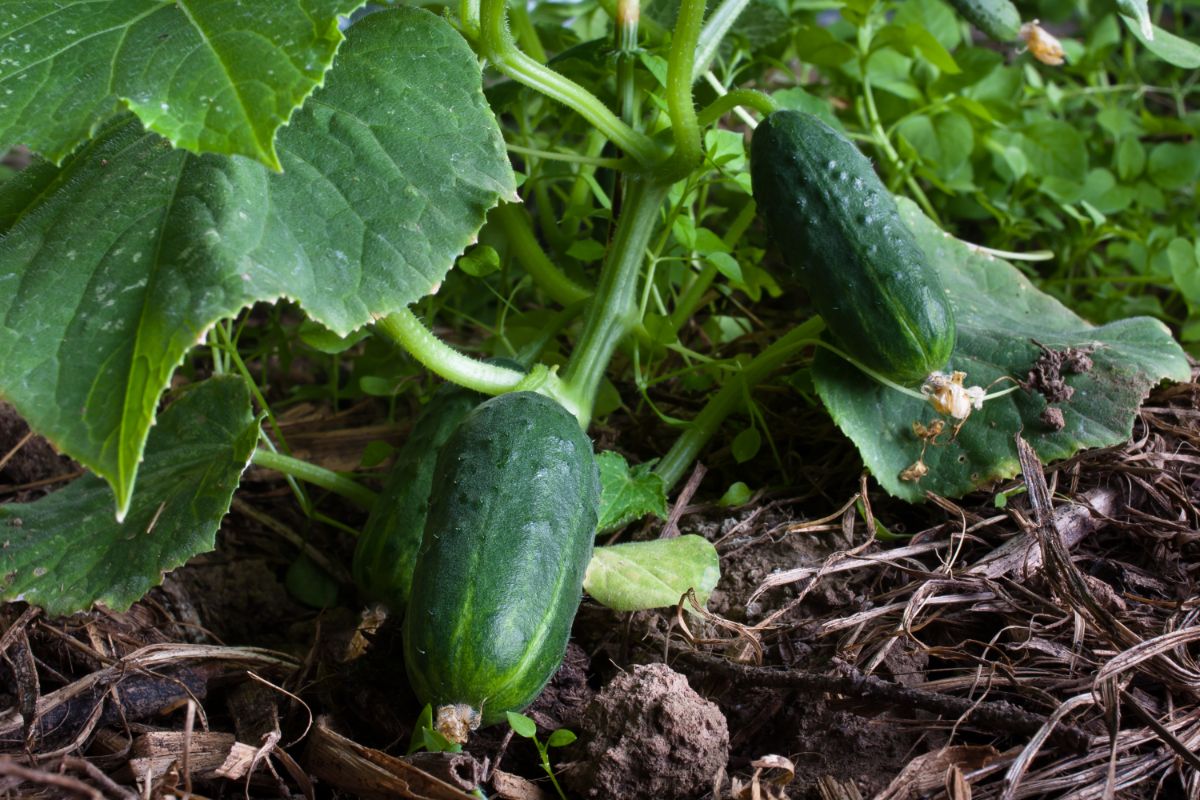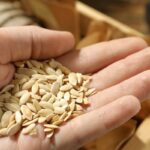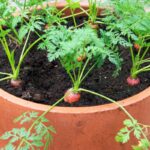Cucumber (Cucumis sativus), a cherished staple in many a salad, is a heat-loving plant that takes pride in its versatility.
Among its many varieties, slicing cucumbers stand out as the most beloved for their crisp, refreshing taste and diverse uses.

In this article, I’ll guide you through the process of growing slicing cucumbers, highlighting the best types, and offering tips on container gardening with barrels. Keep reading!
The Best Slicing Cucumbers To Grow
If you’re setting out to grow slicing cucumbers, the first thing you need to do is understand the different varieties and which ones suit your needs.
The following 3 types of slicing cucumbers are generally the best to grow:
Marketmore 76
First on our list is the widely adored ‘Marketmore 76’, a versatile cucumber with a consistent track record.
It boasts dark green skin and a robust, crisp flavour. As a disease-resistant variety, it is a fantastic choice for novice gardeners.
Straight Eight
The ‘Straight Eight’ cucumber is an old-time favourite that consistently produces long, straight, and perfectly cylindrical fruits.
It’s an heirloom variety known for its dependability and delicious taste, ideal for fresh eating and salad use.
English Cucumbers
Also known as ‘Telegraph cucumbers’, English cucumbers are renowned for their thin skins, virtually seedless flesh, and mild flavour. Their impressive length and elegant shape make them perfect for slicing.
Top Tips For Growing Slicing Cucumbers
1. Preparing The Soil For Slicing Cucumbers
The first step in growing slicing cucumbers involves preparing the soil.
Cucumbers favour well-draining soil enriched with organic matter. Add plenty of compost or well-rotted manure to your chosen plot.
The soil should ideally be slightly acidic to neutral (pH 6.0 – 7.0). This preparation not only provides nutrients but also improves soil structure and water retention.
2. Seeding And Transplanting Cucumbers
You can either sow cucumber seeds directly in the garden or start them indoors if your growing season is short.
Plant your seeds 1 inch deep and space them about 36 inches apart if you’re using a trellising method.
Alternatively, plant 3-4 seeds in hills spaced 48-72 inches apart.
If you’ve started your seeds indoors, wait until they have developed at least two true leaves and the risk of frost has passed before transplanting them into your garden.
Handle seedlings gently to avoid damaging their delicate root systems.
3. Caring For Cucumber Plants
Regular watering is critical for cucumbers, as they are made up of 95% water.
Water deeply once a week, but avoid watering the leaves, which could lead to fungal diseases.
During dry spells, increase the watering frequency. Mulch around the plants can retain soil moisture, suppress weeds, and keep the fruits clean.
Cucumbers are heavy feeders and benefit from additional feeding. Apply a balanced, water-soluble fertiliser every 2-3 weeks or use slow-release granules.
4. Supporting Your Cucumbers
While cucumbers will naturally spread along the ground, supporting them with a trellis or stake has multiple benefits. It keeps the fruits off the ground, reduces the risk of disease, improves air circulation, and makes the cucumbers easier to harvest.
5. Managing Pests And Diseases
Cucumbers can attract various pests, including aphids, cucumber beetles, and slugs. I’ve lost many a cucumber plant to the hungry slugs in my garden!
Monitor your plants regularly for signs of these pests and implement organic control measures if necessary.
Diseases to watch for include powdery mildew, bacterial wilt, and cucumber mosaic virus. Using resistant varieties and implementing crop rotation can help prevent these issues.
6. Companion Planting For Cucumbers
Companion planting can significantly benefit cucumbers. Marigolds, nasturtiums, and tansy can repel harmful pests, while planting cucumbers alongside beans, corn, or peas can provide beneficial shade and create a diverse ecosystem within your garden.

How To Grow Slicing Cucumbers In Barrels
If growing on the ground isn’t an option for you, you can choose to grow your slicing cucumbers in barrels or containers.
Here’s what you need to do:
1. Selecting The Barrel
Choose a clean barrel that’s at least 24 inches in diameter and depth. This can be wooden or food-grade plastic, free of harmful residues.
2. Preparing The Barrel
Drill half-inch drainage holes in the barrel’s bottom, line with stones or broken terracotta pots, and fill with a mixture of compost, perlite, and topsoil. This creates a well-draining environment for your cucumbers.
3. Planting The Seeds
Sow several cucumber seeds around the edge of the barrel and one in the centre, covering lightly with soil. This maximises the use of space, allowing the vines to trail over the barrel’s sides.
4. Maintaining The Barrel Garden
Ensure the barrel receives 6-8 hours of sunlight daily. Water your cucumber plants regularly, and add a balanced fertiliser every 2-3 weeks to support their growth.
When To Harvest Slicing Cucumbers
Knowing when to harvest is as vital as knowing how to grow. Pick your slicing cucumbers when they’re medium to dark green, firm, and have reached their variety-specific size.
For ‘Marketmore 76’ and ‘Straight Eight’, this is typically when they are about 7-8 inches long. English cucumbers can grow up to 12-15 inches while maintaining their tender skin and flavourful flesh.
Regular harvesting is key as it encourages continuous production. Overripe cucumbers may become bitter and can inhibit the growth of new fruits.
Final Thoughts
Growing slicing cucumbers is a fulfilling process that spans from the careful planting of seeds to the rewarding harvest of crisp, tasty slices of cucumber on your summer salad.
By understanding their growth requirements, whether in garden beds or barrels, you can ensure a plentiful harvest.
So, put on your gardening gloves, embrace the journey, and look forward to the delightful crunch of your home-grown slicing cucumbers.
- Can You Grow Bell Peppers Indoors? A Guide For New Gardeners - November 14, 2023
- Composting Basics: Can You Compost Mushrooms? - November 6, 2023
- A Gardener’s Guide To Growing Carrots In Raised Beds - November 1, 2023






